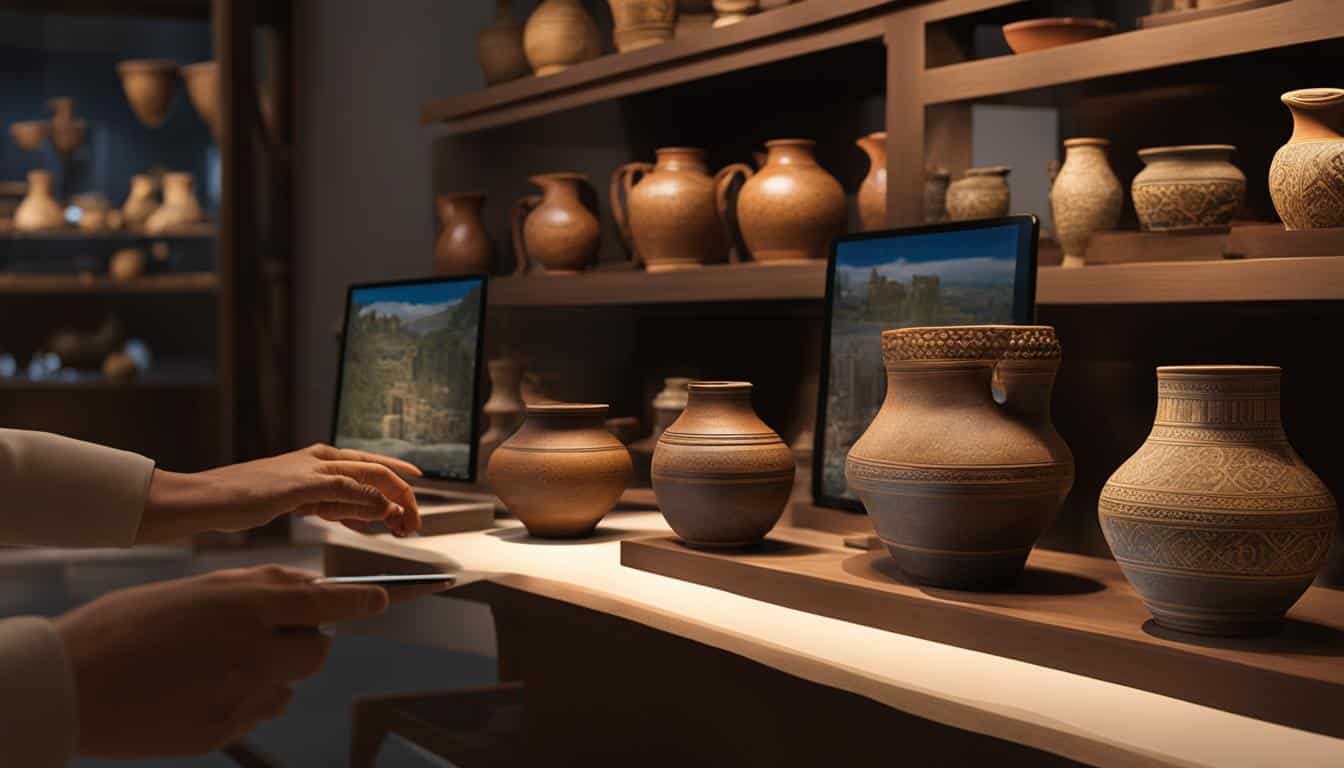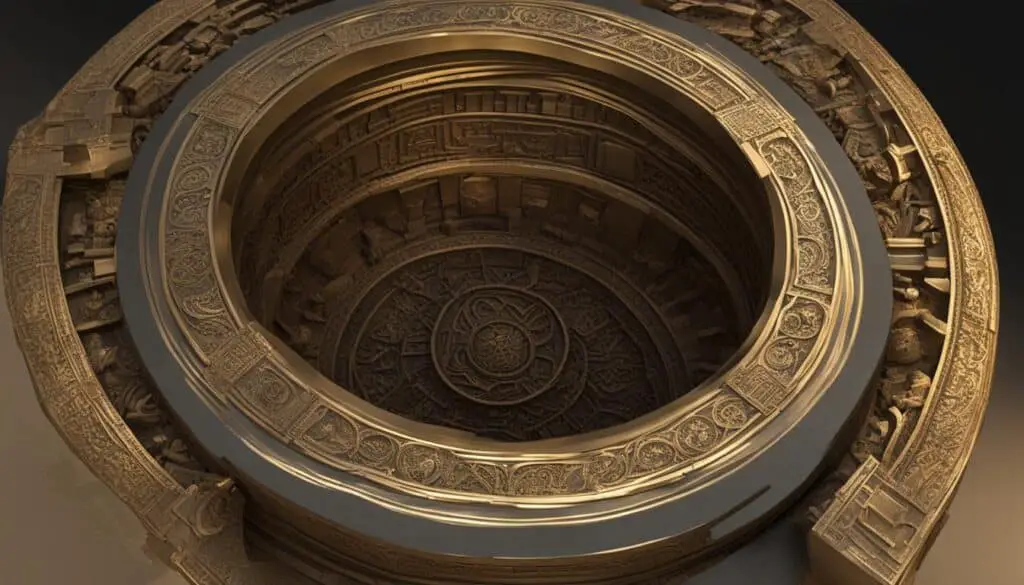
Interactive 3D Models: Bringing Biblical Artifacts to Life
I am excited to introduce you to a fascinating development in the world of archaeology and religious studies: interactive 3D models of biblical artifacts. These innovative models offer a unique and immersive way to explore ancient scriptures and connect with the past in a tangible and engaging manner.
Through advancements in technology, interactive 3D models have revolutionized the study and interpretation of biblical artifacts. By recreating these ancient objects in virtual form, viewers can now examine every intricate detail and gain a deeper understanding of their historical and cultural significance.
Key Takeaways:
- Interactive 3D models provide a unique and immersive way to explore biblical artifacts.
- Visual representation enhances the understanding and appreciation of these artifacts.
- Historical accuracy and contextual insight are key elements in the development of these models.
- Interactive 3D models offer accessibility and can be utilized as educational tools.
- Advancements in technology have made the development of these models possible.
The Importance of Visual Representation
Visual representation plays a vital role in understanding and appreciating biblical artifacts. Through interactive 3D models, details that may be missed in traditional 2D images can be highlighted, allowing for a more comprehensive viewing experience.
When it comes to biblical artifacts, the ability to visually explore and engage with these ancient objects provides invaluable insights into their historical and cultural significance. By leveraging the power of interactive 3D models, viewers are able to immerse themselves in a visually captivating experience that brings these artifacts to life.
Unlike static images or textual descriptions, interactive 3D models offer a dynamic and interactive way to examine biblical artifacts from all angles. Users can rotate, zoom in, and interact with various elements of the model to gain a deeper understanding of the artifact’s form, craftsmanship, and intricate details that might otherwise go unnoticed.
This enhanced visual representation allows for a more comprehensive analysis and interpretation of biblical artifacts, making it easier for scholars, researchers, and enthusiasts to explore their historical and cultural significance. Whether it’s studying the intricate carvings on an ancient stone tablet or examining the delicate details of a religious artifact, interactive 3D models provide a level of visual clarity and accessibility that is unmatched.
Furthermore, visual representation through interactive 3D models bridges the gap between distant museum collections and individuals who may not have the opportunity to visit these institutions in person. Through the power of the internet, anyone with an internet connection can access these models, bringing biblical artifacts to a global audience.
By harnessing the power of visual representation, interactive 3D models offer a transformative approach to experiencing and understanding biblical artifacts.
Not only do interactive 3D models enhance the accessibility of these artifacts, but they also serve as valuable educational tools. They enable educators, students, and enthusiasts to engage with these objects in a visually stimulating and interactive manner that promotes a deeper understanding and appreciation for biblical history and culture.
With the advancements in technology and the increasing availability of high-resolution scanning techniques, the visual representation of biblical artifacts through interactive 3D models continues to evolve and improve. These models provide a bridge between the ancient and the modern, allowing us to connect with biblical artifacts in a way that was once unimaginable.
Through visual representation, interactive 3D models offer a unique and immersive experience that enhances our understanding of biblical artifacts and opens up new avenues for exploration and research. By leveraging technology to bring these ancient objects to life, we can delve deeper into the historical and cultural significance of the biblical narrative.
Historical Accuracy and Contextual Insight
Interactive 3D models of biblical artifacts offer a fascinating glimpse into the past, allowing us to explore ancient scriptures with historical accuracy and contextual insight. These models are the result of meticulous research and attention to detail, aiming to recreate artifacts as authentically as possible, providing valuable information about the time and culture in which they were created.
By studying and analyzing biblical artifacts, researchers and archaeologists gather contextual information that helps paint a vivid picture of the historical and cultural settings in which these objects existed. The ability to visualize these artifacts in a digital space allows for a more immersive experience, where details and nuances can be observed and appreciated in ways that traditional 2D images or written descriptions may not convey.
Through advanced scanning techniques and cutting-edge technology, every aspect of these artifacts can be examined and analyzed, from their materials and craftsmanship to the symbolic motifs and cultural significance they hold. This level of detail and precision enables viewers to gain a deeper understanding of the historical context and enriches their interpretation of ancient texts.
“The historical accuracy and contextual insight provided by interactive 3D models are invaluable in studying biblical artifacts. These digital recreations allow us to delve deeper into the cultural and historical significance of these objects, shedding light on the world in which they were created.”
One of the greatest advantages of interactive 3D models is the opportunity they present for researchers and enthusiasts alike to interact directly with biblical artifacts that may be housed in museums or other collections around the world. These models bridge the gap between physical limitations and the desire to explore and engage with these historical treasures, bringing them to a wider audience and facilitating a deeper connection to our shared heritage.
To illustrate the historical accuracy and contextual insight provided by interactive 3D models, let’s consider an example of a significant biblical artifact – the Dead Sea Scrolls. These ancient manuscripts, discovered in the mid-20th century, contain some of the earliest known versions of the Hebrew Bible and offer invaluable insights into Jewish history and biblical interpretation. Through interactive 3D models, users can examine the intricate details of the scrolls, decipher the ancient text, and gain a better understanding of their historical and religious significance.

Example Table: Historical Accuracy Comparison of Selected Interactive 3D Models
| Biblical Artifact | Historical Accuracy | Contextual Insight |
|---|---|---|
| The Ark of the Covenant | High | Reveals intricate details and construction methods, enhancing our understanding of its significance in ancient Israelite worship and culture. |
| The Rosetta Stone | Medium | Provides an accurate representation of the stone’s inscriptions and allows users to decipher the hieroglyphics using interactive tools, shedding light on ancient Egyptian history and language. |
| The Crown of Thorns | Low | Due to its delicate nature and limited access, historical accuracy is compromised. However, visual representations provide insights into the craftsmanship and symbolism associated with the crown. |
The use of interactive 3D models in exploring biblical artifacts continues to expand and evolve, offering researchers, educators, and enthusiasts an unprecedented level of historical accuracy and contextual insight. These digital tools open doors to new discoveries, inspire curiosity, and foster a deeper appreciation for the ancient world and its enduring impact on our modern society.
Accessibility and Education
The accessibility of interactive 3D models provides a unique opportunity for individuals all over the world to explore and engage with biblical artifacts, regardless of their physical proximity to museum collections. These digital representations bring the artifacts to life, allowing users to examine and interact with them in ways that were previously limited to researchers and experts.
From the comfort of their own homes, students, scholars, and enthusiasts can now access a wealth of information about ancient history and religious texts. These interactive models serve as invaluable educational tools, offering a visual and immersive approach to teaching about biblical artifacts and their cultural significance.
Through the use of interactive 3D models, education is no longer confined to textbooks or static images. Learners can experience a virtual encounter with artifacts, gaining a deeper understanding of their historical context, symbolism, and craftsmanship. The visual and interactive elements of these models cater to different learning styles, making the educational experience more engaging and memorable.
“Interactive 3D models provide a unique opportunity for students to engage with biblical artifacts in a way that fosters curiosity and deeper learning. The ability to manipulate, zoom in, and examine these objects from different angles offers an unprecedented level of access and understanding.”
– Dr. Jane Thompson, Professor of Archaeology, University of XYZ
Enhancing Intercultural Learning and Inclusivity
The accessibility of interactive 3D models extends beyond physical limitations. The digital nature of these models opens doors for individuals who may face obstacles in visiting physical museums due to disabilities, geographical constraints, or financial limitations. This inclusivity ensures that everyone, regardless of their circumstances, can experience and learn from biblical artifacts.
Engaging Classroom Experiences
Integrating interactive 3D models into classroom settings enhances traditional teaching methods, adding a dynamic and interactive element to history and religious studies. Educators can incorporate these models into lesson plans, encouraging students to explore artifacts firsthand and inspiring deeper discussions and critical thinking.
“The introduction of interactive 3D models in my classroom has transformed the learning experience for my students. The ability to manipulate and engage with biblical artifacts has sparked their curiosity and led to rich discussions about the historical and cultural contexts in which these artifacts were created.”
– Sarah Johnson, High School History Teacher, XYZ School
| Benefits of Interactive 3D Models in Education | Examples |
|---|---|
| 1. Enhanced engagement and interactivity | Zooming in on intricate details |
| 2. Accessibility for all learners | Students with physical disabilities |
| 3. Deeper understanding of historical context | Exploring artifacts from different time periods |
| 4. Multisensory learning experiences | Interacting with replica artifacts in virtual reality |
| 5. Inclusive and equitable access to education | Virtual field trips for schools in remote areas |
Advancements in Technology
Advancements in technology have revolutionized the way we explore and interact with ancient artifacts. When it comes to biblical artifacts, interactive 3D models have taken center stage, allowing us to delve deeper into the intricate details of these historical treasures.
Through high-resolution scanning techniques, researchers can capture every intricate detail of the artifacts, preserving them digitally for the future. These models provide a level of realism and accuracy that allows viewers to appreciate the artifacts in ways that were previously unimaginable.
But it doesn’t stop there. The integration of virtual reality (VR) and augmented reality (AR) technologies takes the interactive experience to a whole new level. With VR headsets, viewers can be fully immersed in a virtual environment, surrounded by these ancient artifacts, providing a sense of presence and awe-inspiring realism.
AR, on the other hand, overlays digital content onto the real world. Imagine standing in a room and using your smartphone or tablet to see a biblical artifact come to life right before your eyes. The artifact can be projected onto your surroundings, allowing you to interact with it and gain a deeper understanding of its historical significance.
These advancements in technology have paved the way for a more interactive and engaging exploration of biblical artifacts. Through interactive 3D models, users can now examine these artifacts in unprecedented detail, in ways that were previously only accessible to experts and scholars.
Whether it’s zooming in to scrutinize intricate carvings, rotating the artifact to examine it from every angle, or virtually stepping back in time to experience the context in which it was used, interactive 3D models provide a truly immersive and educational experience.
Let’s take a closer look at the advancements in technology that have made interactive 3D models of biblical artifacts possible:
| Advancement | Description |
|---|---|
| High-resolution scanning | Advanced scanning techniques capture minute details of artifacts, ensuring accurate and realistic digital replicas. |
| Virtual Reality (VR) | VR technology allows users to explore artifacts in a virtual environment, providing an immersive and interactive experience. |
| Augmented Reality (AR) | AR overlays digital content onto the real world, enabling users to interact with virtual artifacts in their physical surroundings. |

With these technological advancements, the possibilities for exploring biblical artifacts are endless. Researchers, educators, and enthusiasts alike can now delve into the intricacies of these historical treasures, gaining valuable insights and fostering a deeper appreciation for our shared cultural heritage.
Conclusion
Interactive 3D models have revolutionized the way we engage with biblical artifacts, offering a captivating and educational experience unlike any other. Through the combination of historical accuracy, visual representation, and accessibility, these models bring the ancient world to life and deepen our understanding of the rich history and religious texts that have shaped our civilization.
By allowing viewers to explore every intricate detail of these artifacts, interactive 3D models provide a level of immersion and connection that traditional 2D images simply cannot replicate. From the intricate carvings on ancient tablets to the delicate craftsmanship of religious relics, these models allow us to appreciate the artistry and cultural significance of these objects in a whole new way.
Furthermore, the accessibility of interactive 3D models ensures that individuals worldwide, regardless of their location, can access and learn from these invaluable artifacts. No longer limited by the constraints of physical proximity to museum collections, these models serve as powerful educational tools that promote inclusivity and expand our knowledge of ancient history and religious traditions. As technology continues to advance, the possibilities for interactive 3D models in the fields of archaeology and religious studies are boundless, promising even more exciting and immersive experiences for future generations.
FAQ
How do interactive 3D models enhance the exploration of biblical artifacts?
Interactive 3D models provide a unique and immersive way to explore ancient scriptures. By bringing these artifacts to life, viewers can have a tangible connection to the past and experience details that may be missed in traditional 2D images.
What benefits do interactive 3D models offer in terms of historical accuracy and contextual insight?
Interactive 3D models aim to recreate biblical artifacts as authentically as possible, offering valuable information about the time and culture in which they were created. Through meticulous research and attention to detail, these models provide a deeper understanding of ancient history and religious texts.
How does the accessibility of interactive 3D models benefit individuals interested in biblical artifacts?
Interactive 3D models allow individuals from all over the world to explore biblical artifacts without physical proximity to museum collections. These models can also be used as educational tools, providing a visual and interactive approach to teaching about ancient history and religious texts.
What technological advancements enable the development of interactive 3D models?
Advancements in technology such as high-resolution scanning, virtual reality, and augmented reality capabilities enhance the user experience, allowing for a more immersive and detailed exploration of these ancient objects.
How do interactive 3D models contribute to promoting an understanding of ancient history and religious texts?
By combining historical accuracy, visual representation, and accessibility, interactive 3D models offer a unique and engaging experience for viewers. These models bring biblical artifacts to life and foster a deeper appreciation and understanding of ancient history and religious texts.
